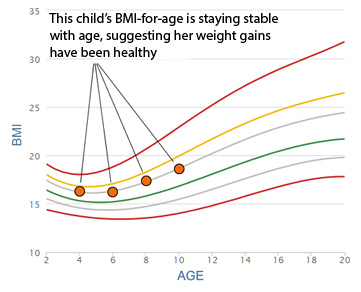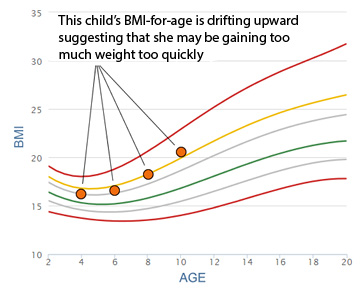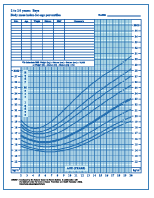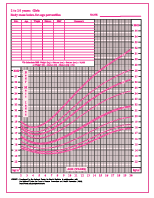Children's Nutrition Research Center
Children's BMI-percentile-for-age Calculator
Use this calculator to determine whether a child is at a healthy weight for his/her height, age and sex (1). The BMI-percentile-for-age calculator automatically adjusts for differences in height, age and sex, making it one of the best tools for evaluating a growing child's weight.
Enter your information into the form below, then click the Calculate button. All fields are required. Dates should be entered in "m/d/yyyy" format.
Interpreting the results
A BMI Percentile-for-Age:
Less than 5%
suggests that the child is
Underweight
5% to less than 85%
suggests that the child is
Healthy Weight
85% to less than 95%
suggests that the child is
Overweight
Equal to or greater than 95%
suggests that the child is
Obese
Should I be concerned if my daughter is in the 75th percentile on the
graph?
Not if that is where she has tended to be on the graph in the past (see tracking your child's weight below).
Being in the 75th percentile means that after adjusting for differences in height your daughter is heavier than
75 percent of girls her age ( and lighter than 25 percent), which, according to the CDC guidelines above, puts
her at a healthy weight-for-age.
What do the Estimated Energy Requirements mean?
The calculated values show the estimated range of Calories needed to simply maintain your child's
current weight
(the weight you entered) based on his/her age, gender, and activity level.
Energy intake data come from the National Research Council, 2005. (2)
What to do if your child's BMI-for-age indicates that he or she is:
overweight or at risk for overweight
The body mass index (BMI) and BMI-percentile-for-age do not directly measure body fat. As a result, although the vast majority of children with a BMI-percentile-for-age over the 85th percentile have too much body fat, very athletic kids, particularly very active athletic African-American teenage boys, can have a high BMI-for-age due to extra muscle mass, not excess body fat. Therefore it's important that children with a BMI-percentile-for-age over the 85th percentile be evaluated by a health professional.
The CNRC has some excellent resources for parents concerned about their child's body weight, including Helping Your Child with Successful Weight Management (also in Spanish), Healthy Eating articles, a Kids' Energy Calculator, and links to Childhood Obesity resources on the internet.
If you suspect a medical condition is causing your child to be overweight or if you suspect your child is developing or has an eating disorder, consult your child's physician.
underweight or possibly at risk for underweight
For very thin children who are growing and developing normally, eating a healthy diet, and are active and energetic, having a BMI-percentile-for-age below the 15th percentile should be considered normal -- some children are just thin.
However, if a child has stopped gaining weight or has recently lost weight, has diarrhea or vomiting, poor appetite, a severely restricted diet, and/or low energy levels, a low BMI-percentile-for-age could signal a medical problem or an eating disorder that deserves attention. Children developing eating disorders also tend to voice concerns over age appropriate weight gains or feel a need to lose weight, have a poor self-body image, exercise excessively, and girls can lose their regular menstrual cycle. Although more common among girls, eating disorders can also affect boys.
If you suspect a medical condition is causing your child to be underweight or if you suspect your child is developing or has an eating disorder, consult your child's physician.
Tracking Your Child's Weight
Plotting a child's BMI-for-age on the appropriate CDC growth chart (see charts on right) can alert parents to early signs that their child is gaining weight too fast, enabling them to help their child avoid developing weight problems by making small changes in their family's diet and physical activity habits. According to Roman Shypailo, a CNRC body composition expert who developed the calculator, parents who plot the calculator results should watch for significant "drifting," either up or down, in their child's BMI-for-age percentile over time.
For example, a 62-pound, 50-inch tall, 8-year-old girl has a BMI of 17.5, which puts her at the 77th percentile for age. This is a healthy weight for her age and her parents should expect future weight gains to keep her BMI-for-age "tracking" along the 77th percentile as she gets older.

However, a BMI-for-age at the 77th percentile could be a 'red flag' for poor diet and/or physical activity habits if it represents an upward drifting of her BMI-for-age percentile, perhaps from the 66th percentile at age 6 to the 70th at age 7 and the 77th at age 8. This 'early warning' enables parents catch potentially unhealthy changes in a child's weight at an early age, when making changes in diet and exercise to correct the problem are easier.

To track changes in your child's BMI-for-age
- Click on the appropriate growth chart below to open a full-size, full-color chart suitable for printing. Plot the BMI Percentile number obtained from the Calculator against your child's age on this chart.
- About every 6 months, return to this page to recalculate your child's BMI Percentile and plot these new points on the chart.
References
(1) Centers for Disease Control and Prevention (CDC). National Center for Health Statistics (NCHS). National Health and Nutrition Examination Survey Data. Hyattsville, MD: U.S. Department of Health and Human Services, Centers for Disease Control and Prevention, 2004, http://www.cdc.gov/growthcharts/percentile_data_files.htm.
(2) National Research Council. Dietary Reference Intakes for Energy, Carbohydrate, Fiber, Fat, Fatty Acids, Cholesterol, Protein, and Amino Acids (Macronutrients) . Washington, DC: The National Academies Press, 2005.

